
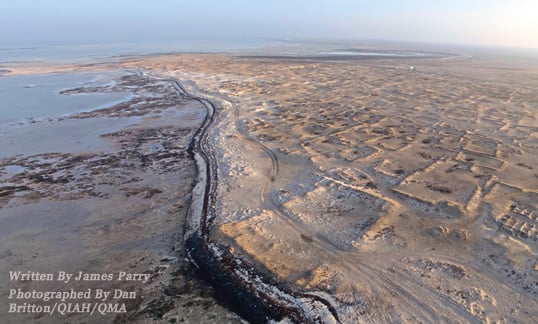 |
| Drifting sand covers much of the ruins of Al Zubarah, which at its height in the late 18th century housed several thousand people and was surrounded by a defensive wall with 22 watchtowers. |
 n the northwest coast of Qatar, the bay’s flat cobalt waters give way gradually to sand and small stony hillocks from which Al Zubarah (“Sand Mound”) may have taken its name but not, explains archeologist Alan Walmsley, its historic reputation.
n the northwest coast of Qatar, the bay’s flat cobalt waters give way gradually to sand and small stony hillocks from which Al Zubarah (“Sand Mound”) may have taken its name but not, explains archeologist Alan Walmsley, its historic reputation.
“It’s very clear,” he explains. “Al Zubarah is not only the best-preserved pearling settlement anywhere in the Gulf, but also an outstanding example of urban planning in the Arabian Peninsula.” It is, he adds, significant enough to “help expand our whole view of how the region’s coastal trading settlements functioned.”
In a region where archeologists often deal in millennia, this is an impressive claim for a site that went from sand to riches and back to sand in just a bit more than a century. Profiting from the nearby pearling banks on the bed of the south-central Gulf, Al Zubarah (ahl zoo-bar-ah) became a wealthy trading hub during the mid- to late 1700’s. Its affluent merchant class built what must have been an imposing, walled town that was home to several thousand people. Though it was attacked and largely destroyed in the early 1800’s, its story illuminates the vitality of the Gulf’s preindustrial coastal economies that thrived on “white gold”—pearls.
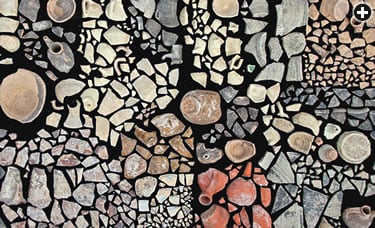 |
| Puzzle pieces of the emerging story of the Gulf-wide boom in “white gold,” as pearls were sometimes called, more than 60,000 pottery fragments have been recovered from Al Zubarah. |
Pearling is an industry of great antiquity. The earliest pearls yet discovered are estimated to be as much as 7500 years old, unearthed at the Neolithic sites of Al-Sabiyah in Kuwait and Umm al-Quwain 2 in the United Arab Emirates. Those and other excavations indicate that even then pearls were accorded high status as jewelry, and they were featured in burial chambers. “Pearling dominated the thoughts and way of life of nearly all the coastal inhabitants of the Gulf for centuries,” wrote Robert A. Carter in his 2012 book, Sea of Pearls.
Exactly how important pearls were to Al Zubarah and how important Al Zubarah was in its historical era are the subjects of the 10-year Qatar Islamic Archaeology and Heritage Project (qiah), founded in 2009 and led by the Antiquities Department of the Qatar Museums Authority (qma) in association with the University of Copenhagen. Although limited excavations took place in the 1980’s and early 2000’s, until very recently the precise extent and character of the town remained largely cloaked in mystery, even though what was thought to be the key event in its demise was well recorded: In 1811 Al Zubarah was bombarded from the sea by Omani ships, devastated by fire and reduced to ruins. Historians traditionally understood that its inhabitants had fled as a result and that the town had been totally abandoned. Now, the qma project is finding evidence that challenges this version of events and suggests a more complex and nuanced process of occupation, partial abandonment and re-occupation.
 hough sources are scarce, the story of Al Zubarah appears to begin in the 1760’s with the arrival of families belonging to the ‘Utub, a coalition of tribes that emerged from central Arabia during the late 1600’s. Among them was the Al Khalifah clan, which is now the ruling family of neighboring Bahrain. The ‘Utub established a headquarters in Kuwait, and by 1765 they boasted a pearling fleet of some 800 boats. Determined to extend their influence, they colonized Al Zubarah and established a trading hub there. Merchants came from elsewhere in the Gulf, favoring Al Zubarah at a time when other trade centers such as Basra were under pressure from outbreaks of plague and the threat of Persian attack.
hough sources are scarce, the story of Al Zubarah appears to begin in the 1760’s with the arrival of families belonging to the ‘Utub, a coalition of tribes that emerged from central Arabia during the late 1600’s. Among them was the Al Khalifah clan, which is now the ruling family of neighboring Bahrain. The ‘Utub established a headquarters in Kuwait, and by 1765 they boasted a pearling fleet of some 800 boats. Determined to extend their influence, they colonized Al Zubarah and established a trading hub there. Merchants came from elsewhere in the Gulf, favoring Al Zubarah at a time when other trade centers such as Basra were under pressure from outbreaks of plague and the threat of Persian attack.
 |
| The impressive fort was built in 1938, almost a century after Al Zubarah’s fall from prominence. It is currently under restoration. |
Under the ‘Utub, and equipped with its own pearling fleet, Al Zubarah quickly flourished—so much so that an ambitious town was built in a decade or less. Trade links extended across the Gulf, to the Indian Ocean and beyond. Yet its meteoric rise was short-lived. Other, rival pearling settlements had sprung up along the Gulf coast, too, among them the precursors of Dubai and Abu Dhabi. The intensity of the economic rivalries among the coastal towns was compounded by the fragility of local tribal and family alliances, which were often racked by disputes.
The late 1770’s were also a time of wider political instability. Just some 40 kilometers (25 mi) north by sea, Persians from Bushehr had established a governor on the island of Bahrain. To the Persians, Al Zubarah was an upstart threat, and hostility culminated in battle in 1783. The ’Utub prevailed and seized Bahrain. Prominent among Al Zubarah residents who relocated to Bahrain were members of the Al Khalifah clan.
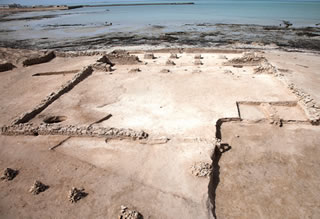 |
| alexis pantos / qiah / qma |
| Evidence that Al Zubarah was part of a larger system of coastal trading and farming, the outlines of this former mosque are in Freiha, north of Al Zubarah. |
This movement of people, and the shift in economic focus to Bahrain that went with it, was fueled also by a second threat—one from inland. United under Muslim theologian Mohammed ibn Abd al-Wahhab, other tribal groupings traveled out from central Arabia to menace coastal towns, including Al Zubarah. As an island, Bahrain offered a measure of safety.
Meanwhile, international powers, too, were turning attention to the region. The British were anxious to contain the Qawasim, a tribe based at Ras Al Khaimah, along the Gulf coast northeast of Al Zubarah, whom the British accused of masterminding pirate attacks on British ships passing through the Gulf to and from India. To suppress the Qawasim, the British entered into a treaty with the Omanis, who were similarly concerned for their own vessels.
 |
| alexis pantos / qiah / qma |
| With no later towns or cities covering it, Al Zubarah is “a place of outstanding cultural integrity,” says Faisal Al-Naimi, director of archeology for the Qatar Museum Authority. |
In 1809, the Wahhab-inspired tribes joined the Qawasim to occupy Al Zubarah. This gave the British–Omani alliance a chance to kill two birds with one stone. The British had already attacked other Qawasim-held ports, and the Omanis decided to attack Al Zubarah. One day in 1811, they sailed to the town and bombarded it with their cannons. The ensuing panic and fire left the town largely in ruins.
So swift was its rise and fall that no description has yet been found of Al Zubarah in its prime. More than a decade after the attack, in 1824, Captain George Barnes Brucks of the East India Company recorded it as “a large town, now in ruins. It is situated in a bay, and has been, before it was destroyed, a place of considerable trade.” This evocative and elusive history forms the backdrop to the current project, which is trying to piece together the character of the town at the peak of its prosperity in the late 18th century. For the past four years, an international team of more than 70 experts has worked at Al Zubarah each autumn and winter, spending several months researching, surveying, excavating and cataloguing what is now recognized as one of the Gulf’s most important historic sites. The team seeks answers to questions about the layout of the town, which activities took place and where, and how Al Zubarah’s inhabitants lived and worked to earn the wealth that built so much so fast.
 ith these questions in mind, I wandered through the remains of the town. It covers 61 hectares (150 acres), about the area of a dozen soccer fields. On the landward side, it is bounded by the remnants of its 2½ -kilometer (1½-mi) defensive wall, which reached five meters (16') in height and featured 22 watchtowers at intervals. Geophysical surveys, radar tracking and traditional digging have revealed a regular, grid-like street pattern inside the wall, with frameworks for residential compounds—one clearly palatial—as well as workshops and other spaces.
ith these questions in mind, I wandered through the remains of the town. It covers 61 hectares (150 acres), about the area of a dozen soccer fields. On the landward side, it is bounded by the remnants of its 2½ -kilometer (1½-mi) defensive wall, which reached five meters (16') in height and featured 22 watchtowers at intervals. Geophysical surveys, radar tracking and traditional digging have revealed a regular, grid-like street pattern inside the wall, with frameworks for residential compounds—one clearly palatial—as well as workshops and other spaces.
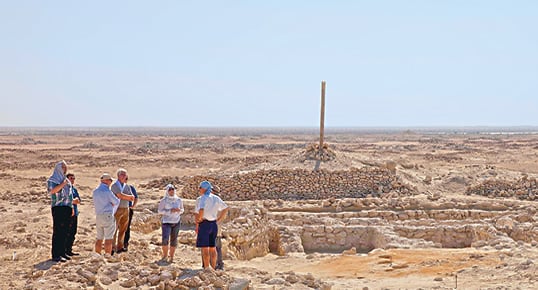 |
| Project director Ingolf Thuesen of the University of Copenhagen shows visitors the market and workshop area of Al Zubarah. For the past four years, an international team of more than 70 experts has worked at the site each autumn and winter, researching, surveying, excavating and cataloging. |
The houses are mostly built around courtyards, points out archeological supervisor Tom Collie. As I explore, I can see that some are distinctly more ambitious in size and design than others. “The building materials vary, but we have found that better quality stone was used for the more elaborate and important structures,” explains Collie. He shows me how the basic construction technique is of roughly hewn beach rock, sealed and protected by a lime-based plaster. On the wall plaster of one courtyard house, I spot a well-preserved if simple etching of a dhow, an emblem of the crucial role played by seaborne trade in the history of the town.
What the teams are finding is that, despite its brief history, Al Zubarah has layers, different levels of construction that highlight dramatically shifting fortunes, like a Gulf version of the 19th-century gold rush towns in the us—a place of rapid change and fast money. The town at its largest extent was laid out in a single phase during the 1760’s and 1780’s, although it is now clear that this plan replaced an earlier and smaller settlement of tents and huts, probably inhabited by fishermen and their families. Of particular interest is an area excavated at the western end of the town, directly above the beach. Here, numerous post- and stake-holes, ovens and fire pits indicate temporary occupation in the form of tents and/or palm huts during a period that coincides with the major phase of the town’s construction. This suggests the presence of economic migrants who would have come to supplement resident pearl fishers during the annual “white gold” harvest, or pearling season from May through September.
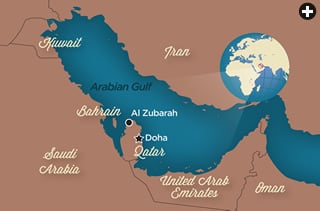 |
Meanwhile, the town shows evidence that pearling was far from the only source of prosperity. Warehouses and markets have been discovered in the central, seaward part of the town. “These point toward production and trade in different commodities, including ironsmithing and other artisanal enterprises,” says archeological supervisor Mike House. He takes me to an area of open-air enclosures, which he explains were probably used for livestock. Far from being just workers in a “pearling town,” the people of Al Zubarah “were always trying different ways of making money,” suggests House.
In the same way that the excavations are showing pearling to be one of several sources of Al Zubarah’s prosperity, so they are also turning another totemic chapter in the town’s history on its head: the infamous attack of 1811. Far from being Al Zubarah’s supposed Armageddon, the archeology is showing this event was in fact rather less than cataclysmic. For a start, the town was already past its prime. “After analyzing the different construction layers, we now think that Al Zubarah was already in decline when the Omanis fired their cannons,” explains Walmsley, who serves as archeology director for the qiah. “Some major buildings had certainly been stripped and abandoned in the years before the Omani attack.” This new evidence supports the historical data suggesting that the populace had already started leaving the town well before the Omani navy showed up.
 Equally, while the 1811 bombardment prompted a sizeable exodus, this was only an initial response: Some people, at least, soon returned, and they may have lived in temporary structures, indicating recolonization in the 1820’s. Work done around that time included the construction of an inner wall, built over collapsed earlier buildings and marking the contraction of the town’s extent to approximately one-fifth of its original size. Similarly, the commercial quarter was scaled down and rebuilt, some damaged buildings having been demolished and others reconstructed using salvaged, often inferior material.
Equally, while the 1811 bombardment prompted a sizeable exodus, this was only an initial response: Some people, at least, soon returned, and they may have lived in temporary structures, indicating recolonization in the 1820’s. Work done around that time included the construction of an inner wall, built over collapsed earlier buildings and marking the contraction of the town’s extent to approximately one-fifth of its original size. Similarly, the commercial quarter was scaled down and rebuilt, some damaged buildings having been demolished and others reconstructed using salvaged, often inferior material.
Tribal tensions continued throughout the region, and in 1878 Al Zubarah was attacked again, this time by Shaykh Jassim bin Mohammed Al Thani, one of the founders of the modern state of Qatar, which his family continues to rule. Al Zubarah thus remained occupied on this reduced scale until the end of the 19th century, when it was again abandoned, and thereafter used only sporadically.
 |
| Conservation specialist Nadia Tsatsoulie fits sherds together to reconstruct a broken pot. Right: Marianne Schwartz uses a microscope while removing corrosion that may hide inscriptions on a coin. |
In addition to the remains of walls and some roofs, by far the greatest number of finds unearthed at Al Zubarah to date are pottery. Some 60,000 fragments, known as sherds, have been examined since 2009. Many have been retrieved from the middens or rubbish heaps found throughout the site, often on the landward side of the perimeter wall. “I have to navigate my way through piles of sherds,” explains research ceramicist Agnieszka Bystron, “sorting them into type and date. Surprisingly small details, such as subtle changes in the shape of a floral design, can give away the date of a piece.” Bystron guides me through a wide variety of pottery, including Julfar ware from Ras Al-Khaimah, pots from Khunj in Iran, tall, thin “torpedo” jars for transporting liquids, decorated tobacco pipes, specialist water containers produced by craftsmen in the Bahraini village of Aali, and one mysterious black vessel, its provenance unknown but possibly from India or perhaps Iran. There are also pieces of Chinese porcelain dating to the 18th and 19th centuries, as well as European porcelain that is usually of a later date. One interesting blue-and-white bowl has a riveting wire and drill hole, indicating that particularly prized or expensive objects were not discarded when broken, but mended and reused.
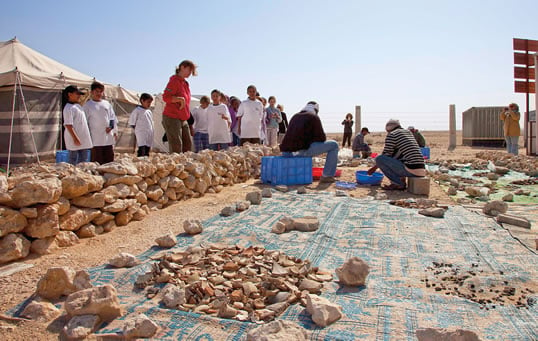 |
| Archeologists give visiting students a lesson in washing and sorting pottery. Some 1000 students visit Al Zubarah annually to learn about the site and its history, and to see archeology in process. |
Other finds reveal much about cooking and the inhabitants’ diets, which, not surprisingly, prominently feature fish. Yet there are surprises: Among the vast quantities of fish bones are those of sawfish, which today is very scarce in Gulf waters, as well as specimens of more common species that are much larger than any caught today, which indicates that today’s fishing industry is netting fish well before they reach maximum size. And pearls, of course, are produced by oysters, which were eaten and their shells discarded into middens that the team are finding run as deep as three meters (nearly 10'). A large number of date presses have been found, indicating the production of date syrup; evidence of rice, wheat, barley and fava beans, as well as fruits such as coconuts, peaches, apricots, walnuts, grapes and plums, all indicate diverse trade networks and purchasing power.
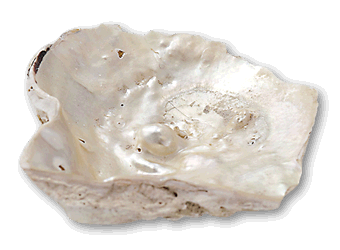 |
| alexis pantos |
| This partially formed pearl was found, discarded with its oyster’s shell, outside a 19th-century building. Pearls form when the oyster secretes nacre, a calcium-carbonate protective coating, over a small intruding object. |
Among the finds directly connected to pearling, there are only a few actual pearls. Holly Parton, who tracks the site’s inventory of finds, says this is to be expected, given their value and portability: They would have been among the first objects carried away by residents moving or even fleeing. There are, however, a variety of objects that would have been used by pearl divers and traders: an 18th-century pearl merchant’s chest, a pearling knife and teardrop-shaped diving weights made of hematite, a mineral form of iron oxide. These helped the divers descend to more than 50 meters (160’) beneath the waves in search of their prize. In all, more than 200 objects have been sent to Doha for display in the new National Museum scheduled to open in December 2014.
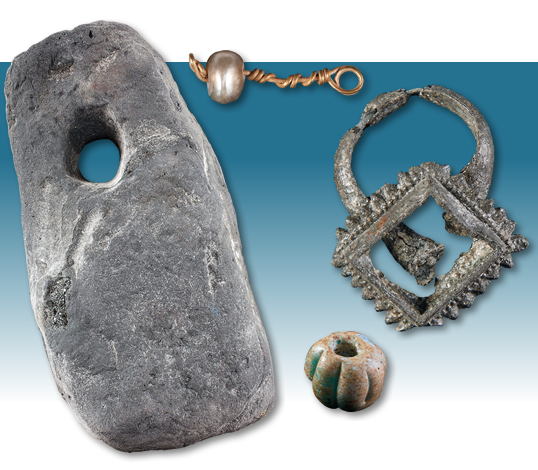 |
| Left: A diving weight, made of hematite (iron ore), helped pearl divers descend more than 50 meters. Top: A mother-of-pearl bead, on a gold wire, is a rare find: Jewelry usually left Al Zubarah with departing residents. Lower: This glass and faience bead was wound on a mandrel and smoothed to fuse its layers. Right: This flattened silver ring was found in a midden (trash heap) inside the city wall. |
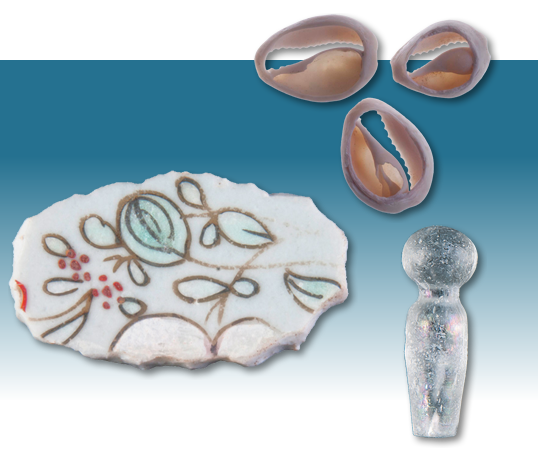 |
Left: This ceramic fragment may once have been part of a Chinese bowl, later reused as an inlay for a pendant. It is estimated to date to the 19th century, as is this glass stopper for a bottle, right. Top: Cowrie shells with their tops removed could have been used as jewelry or game pieces. These were found in Al Zubarah’s market and commercial area. |
 nterest in the finds is being matched by what Al Zubarah’s urban topography says about Gulf settlements. Walmsley, who has specialized for three decades in archeology in Syria, Jordan and Palestine, explains that Al Zubarah demonstrates none of the complicated, organic urban layout so typical of old, traditional Middle Eastern towns. “Al Zubarah does not correspond to the established notion of Islamic cities developing in an intrinsically chaotic or unplanned way,” he says. “Things were much more organized here, which indicates that there was a central authority responsible for the town’s design and construction.” It is not yet clear who might have offered such direction, but such vision and organization would probably have come from a sophisticated individual supported by worldly advisers.
nterest in the finds is being matched by what Al Zubarah’s urban topography says about Gulf settlements. Walmsley, who has specialized for three decades in archeology in Syria, Jordan and Palestine, explains that Al Zubarah demonstrates none of the complicated, organic urban layout so typical of old, traditional Middle Eastern towns. “Al Zubarah does not correspond to the established notion of Islamic cities developing in an intrinsically chaotic or unplanned way,” he says. “Things were much more organized here, which indicates that there was a central authority responsible for the town’s design and construction.” It is not yet clear who might have offered such direction, but such vision and organization would probably have come from a sophisticated individual supported by worldly advisers.
Such discoveries and new questions underscore how little is still understood about the urban archeology of smaller Gulf towns and cities. With the direct evidence for most of them now out of sight, buried beneath modern development, Al Zubarah offers an exceptional opportunity to understand how people in such settlements lived, worked and related to others around them.
 |
| agnieszka bystron / qiah / qma |
| With most of the layout of the town now known, there are opportunities to learn more about how people lived, worked and related to others. |
 o understand even more about the latter, I traveled a few kilometers north along the coast to Freiha, another “lost” town that, like Al Zubarah, is helping historians understand the fickle fortunes of coastal trading ports. Ceramic finds confirm Freiha predates Al Zubarah, but excavations indicate a similar type of evolving, boom-and-bust settlement pattern. What makes Freiha most interesting is a settlement around a spring, on higher ground inland from the main port.
o understand even more about the latter, I traveled a few kilometers north along the coast to Freiha, another “lost” town that, like Al Zubarah, is helping historians understand the fickle fortunes of coastal trading ports. Ceramic finds confirm Freiha predates Al Zubarah, but excavations indicate a similar type of evolving, boom-and-bust settlement pattern. What makes Freiha most interesting is a settlement around a spring, on higher ground inland from the main port.
Stumps of long-dead date palms indicate that this was farmland, likely capable of supplying the port with seasonal fresh produce otherwise difficult to obtain. It is fair to guess that such arrangements were in place elsewhere, and formed part of the coast’s supporting hinterlands. A 19th-century reference to 20 forts “in and around Al Zubarah” has been supported by surveys indicating former field systems and enclosures. This network of small-scale rural settlements, located slightly inland near freshwater sources, would have served as satellites to the coastal towns and provided Al Zubarah in particular with vital supplies.
This improved understanding of how the network of small trading “city-states” of the southern Gulf connected socially and economically both to each other and to their hinterlands is one of the most valuable outcomes to date of the qiah project. Equally significant are the indications that the 1811 bombardment, while important, was not determinative, and that Al Zubarah thrived on more than just pearling.
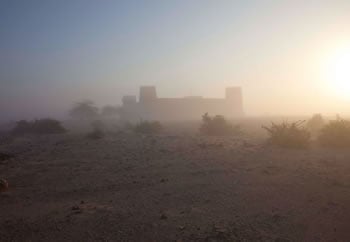 |
| Following restoration, Al Zubarah’s fort will become the Qatar Museum Authority’s visitor center. |
All this points finally to decline that was similarly due to multiple events, and not just local ones. The Gulf pearl trade collapsed following the influx of Japanese cultured pearls from the 1920’s onward. From 1869, the Suez Canal repositioned hemispheric trade routes, effectively reducing the Gulf’s shipping to regional rather than global traffic. Locally, overexploitation of water resources appears to have hastened drought and agricultural decline. Conservation work at Al Zubarah has been limited so far to the rebuilding and consolidation of sections of the outer wall, one of the towers and a few domestic dwellings within the largest of the compounds. Although none have been reconstructed, walls have been stabilized, historic plaster sections reattached where possible and a new plaster applied where necessary. This has helped to begin to recreate for today how the town would have looked in its heyday 250 years ago; for the first time in at least a century it is now possible to stroll along the sandy streets and stand on a section of the boundary wall that once protected Al Zubarah’s inhabitants.
“Al Zubarah is a place of outstanding cultural integrity,” explains Faisal Al Naimi, head of archeology at the Qatar Museum Authority. “It sheds unique light on the history not just of Qatar but of the whole region. We are privileged to be unveiling its rich heritage to the world.”
 |
James Parry (www.jamesvparry.com) is a historian, author and lecturer who specializes in the history and heritage of the Arabian Peninsula. He has worked and lived in several Middle Eastern countries, and currently resides in Norfolk, England. |
 |
Dan Britton (brittondan@hotmail.com) is a freelance photographer and archeologist with the University of Copenhagen who uses studio, field and kite photography to record the Qatar Islamic Archaeology & Heritage project at Al Zubarah on behalf of the Qatar Museum Authority. |